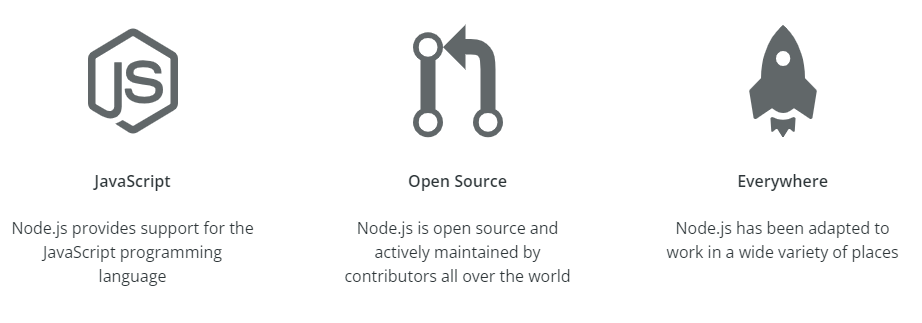
Handy Ideas of What Can You Do with Node.js and Why Is It Worth It
What do Spotify, Netflix, Twitter, and Adobe have in common? Taking advantage of the benefits provided in the package with Node.js. Netflix has reduced the time it takes to launch its streaming service. Twitter has also achieved better performance, further reducing the cost of maintaining the platform. Do you also want to do this? This article will tell you whether Node.js might be a good solution for you.
What is Node.js?
Node.js is an asynchronous runtime environment based on the JavaScript engine. Node.js executes JS code outside of the browser. Thanks to this, we can write backend applications that communicate with databases and create APIs that can be used in the frontend.
Node.js is also a command line script, allowing, for example, to automate repetitive tasks or to perform more complex tasks. It has been used to create tools such as ESLint, a script that checks a code's compliance with the standards.
Advantages and disadvantages of Node.js
Like any tool, Node.js should be put to use where it works best. To be able to decide on the superiority of one solution over the other, it's good to know their advantages and disadvantages. Below you'll find those related to Node.js.
Asynchronicity
The ability to handle requests asynchronously has a very positive effect on the performance of Node.js applications. Especially when it comes to microservices - small parts of applications that are developed and implemented independently. Due to their nature, microservices often communicate with each other. In a synchronous (and single-threaded) world, their main job would be, therefore, to wait for a response. The asynchronous approach, however, poses a threat of falling into a callback hell, that is, the moment when we’re waiting for one answer and on its basis, we send a query for more data, and more, and more. This has a very negative impact on the performance and quality of the code, which may be very difficult to understand and maintain in such cases.
Popularity
Node.js is a very popular technology, used by at least 30 million websites (source: W3Techs). For this reason, it's easy to find good sources of knowledge, such as nodejs.dev/learn, and great ready-made solutions, e.g. Express.js. There are also many specialists from whom you can learn directly. You can find the list of places where you can establish a connection with the community in the Get involved section of the Node.js website.
Due to its popularity, Node.js can also be considered a safe and reliable tool. The popularity, and thus the number of websites using the tool, increases the chances of finding and fixing security holes and other bugs, the elimination of which increases the stability of the solution.
Another advantage of its popularity is the significant number of solutions based on Node.js.- Next.js, Strapi, Meteor.js, Hapi, and Fastify are just a few of them. Each of these frameworks has a large community and offers many sources of knowledge.

Source: nodejs.dev
Scalability
Due to its structure (threads supporting asynchronous input-output operations), Node.js is an easily scalable tool. This can be done either by increasing the server's processing power or by adding multiple servers.
Poor performance of CPU-intensive tasks
The default single-threading of Node.js makes it impossible to use the full power of a processor. Because of this, computations that require significant CPU resources become slow. It's possible to optimize Node.js for CPU-intensive tasks by delegating these computations to a separate thread. However, the overall performance for these types of tasks is better in competitor solutions built for developing applications that will perform CPU-intensive tasks.
What can you do with Node.js?
Node.js is perfect for server-side content rendering, file management, data collection, or database communication. This environment is also good for creating tools to help with development, automation (e.g. Grunt or Gulp), and maintaining code standards (e.g. ESLint or JSLint).
Single Page Application
Node.js comes in handy when creating SPA (Single Page Applications). It's a kind of web application that runs on a single page, and the interaction consists in replacing its parts instead of reloading the entire page, which makes the application feel more fluid. Frequent communication with the backend is not uncommon in this type of application.
The most popular examples of SPAs are Gmail and Netflix. Although both platforms perform very different tasks, as single page applications they take advantage of the Node.js benefits, such as short response time.
REST API
REST (Representational State Transfer) API can be created very quickly using Node.js. Thanks to its popularity, there are already many tools that systematize the way of building REST API. One such tool is the already mentioned Express.js, a framework that allows building RESTful API.
Automation
The number of available libraries and the lightness of Node.js encourages using it as a tool to automate tasks. There are even ready-made solutions, such as Robot.js, which make it possible to automate the most common activities. The cross-platform nature of Node.js allows you to use the tools in many environments.
Developer tools
Due to its nature, Node.js works well as a basis for a developer tool. Developers eagerly use Node.js for this purpose, creating solutions that support their work. One of them is ESLint, a static code analysis tool that identifies problems in JS code.
What can you do with Node.js? Summary
Node.js is certainly an environment worthy of attention. It can be applied in many things, from the automation of repetitive activities to complex and extensive applications used by millions of people every day. We'll be happy to help you create systems using Node.js.











